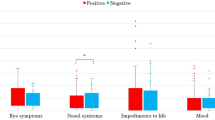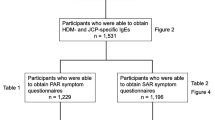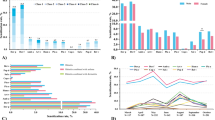Abstract
Purpose
The purpose of the current study is to evaluate the relation between various specific class E immunoglobulins (IgE) in the serum and allergic conjunctivitis in autumn.
Methods
Total IgE and specific IgE to 12 inhalant allergens were measured using the CAP system in 32 patients with allergic conjunctivitis in spring (spring group), 27 patients with allergic conjunctivitis in autumn (autumn group), and 40 healthy volunteers (control group).
Results
Specific IgE levels caused by house dust, Dermatophagoides pteronyssinus, and orchard grass were higher in the autumn group than in the spring group. The highest positivity rate for a specific allergen was 51.9% for house dust, followed by D. pteronyssinus(48.1%) in the autumn group, while the highest rate was 68.8 % for cedar pollen, followed by cypress pollen (59.4%) in the spring group. Correlation analysis showed that house dust was significantly correlated with animal epithelia, D. pteronyssinus, acarus, and Alternaria tenuisin the autumn group (P<0.001).
Conclusions
These results suggest that house dust is the main cause of allergic conjunctivitis during autumn. In spring, cypress pollen is the largest cause of allergic conjunctivitis, while indoor allergens such as house dust, animal epithelia, D. pteronyssinus, and acarus are not causative allergens in Japan.
Similar content being viewed by others
Log in or create a free account to read this content
Gain free access to this article, as well as selected content from this journal and more on nature.com
or
References
Suzuki M, Itoh H, Sugiyama K, Takagi I, Nishimura J, Kato K et al. Causative allergens of allergic rhinitis in Japan with special reference to silkworm moth allergen. Allergy 1995; 50: 23–27.
Plebani M, Faggian D, Borghesan F . Full automation in allergy testing: measurement of specific IgE by the ENEA System. Allergy 1995; 50: 229–233.
Kerkhof M, Schouten JP, de Monchy JG . The association of sensitization to inhalant allergens with allergy symptoms: the influence of bronchial hyperresponsiveness and blood eosinophil count. Clin Exp Allergy 2000; 30: 1387–1394.
Mimura T, Amano S, Funatsu H, Yamagami S, Araie M, Kaji Y et al. Correlations between allergen-specific IgE serum levels in patients with allergic conjunctivitis in spring. Ocul Immunol Inflam 2004; 12: 45–51.
Ben Ezra D . Guidelines on the diagnosis and treatment of conjunctivitis. Ocul Immunol Inflam 1994; 2(Suppl): 17–26.
Axen R, Drevin H, Kober A, Yman L . A new laboratory diagnostic system applied to allergy testing (abstract). Allergy Proc 1998; 9: 503.
Duc J, Peitrequin R, Pcoud A . Value of a new screening test for respiratory allergy. Allergy 1988; 43: 332–337.
Ewan PW, Coote D . Evaluation of a capsulated hydrophilic carrier polymer (the ImmunoCAP) for measurement of specific IgE antibodies. Allergy 1990; 45: 22–29.
Fujishima H, Sahashi N, Shimazaki J, Tsubota K . Allergic conjunctivitis caused by sugi (Cryptomeria japonica D. Don) pollen out of season. Asian Pac J Allergy Immunol 1995; 13: 113–117.
Author information
Authors and Affiliations
Corresponding author
Additional information
The authors have no commercial or proprietary interest in the product or company described in the current article.
Rights and permissions
About this article
Cite this article
Mimura, T., Yamagami, S., Amano, S. et al. Allergens in Japanese patients with allergic conjunctivitis in autumn. Eye 19, 995–999 (2005). https://doi.org/10.1038/sj.eye.6701701
Received:
Accepted:
Published:
Issue date:
DOI: https://doi.org/10.1038/sj.eye.6701701
Keywords
This article is cited by
-
Specific IgG for cat allergens in patients with allergic conjunctivitis
International Ophthalmology (2015)
-
Relationship between refraction and allergic conjunctivitis
Eye (2009)



